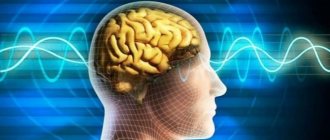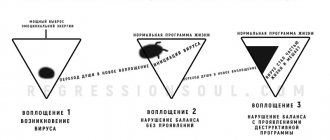Ericksonian hypnosis was created by Milton Erickson, an American psychiatrist and psychotherapist. This is a gentle and non-directive hypnosis. Milton Erickson first used self-hypnosis for himself, and then began to use these techniques in working with patients. So gradually a separate direction took shape.
Milton Erickson considered trance to be a natural human state that occurs many times a day and is necessary for processing and assimilation of experience.
Pantry of the subconscious
The fundamental difference between Erickson’s approach to the unconscious is that he was one of the first psychotherapists to view the subconscious not as a source of problems, but as a huge reservoir of potential resources and opportunities - health, well-being, achievements, successes, victories, joyful and happy moments when something you have experienced. Unfortunately, this powerful reservoir of resources is not available to most people in everyday life, however, it can be accessed through hypnosis and all these resources can be activated for the benefit of the person.
To all that has been said, we can add that today scientists, using modern instruments for studying brain activity, have established that in a state of trance, the work of the left and right hemispheres of the brain is balanced, and as a result of this, our brain enters the mode of operation in the alpha rhythm, which already in itself has a healing effect on the entire human body and psyche. In addition, when working with negative experiences in a state of hypnotic trance, you have the opportunity to relive these situations in a safe environment and, using the tips and help of a therapist, find new ways to solve difficult situations.
As a result of this, a new experience of positive experiences is recorded in the subconscious, for which it does not matter whether the solution to the problem occurred in real life or in a hypnotic trance. This leads to a restructuring of the psyche, and problems, illnesses and difficulties remain in the past. Hypnosis, therefore, is the assistance provided by the therapist so that the patient enters a trance state, turning the focus of his attention inward, and launches unconscious internal mechanisms for finding a solution to his problem.
Postulates of a successful psychiatrist
In the course of his numerous hypno-therapeutic practices, Erickson derived a universal formula - the key to unlimited human capabilities:
1. Everything is OK with each person (with me, and with you (even if you don’t think so yet), and with him, no matter how strange it may sound given his illnesses).
2. Everyone has enough resources (to be happy, to change, and so on. Knowing Milton Erickson’s way of overcoming difficulties and health problems, it is difficult to doubt his words).
3. When committing actions (actions), we are guided by good intentions (even when committing murder, a person justifies himself with good goals).
4. Everyone makes the best choice at any given time (and by reading this article you are making the best choice).
5. Changes are inevitable (including with me, who wrote, and with you, reading the article).
But in fact... Maybe we should think about it? And then many problems in your life will disappear by themselves.
Milton Erickson died in 1980. His work and his experience formed the basis of a separate branch of hypnotherapy, which was named after him - Ericksonian hypnosis. In addition, neuro-linguistic programming (NLP) was invented based on the teachings and works of Erickson.
Benefits of Ericksonian Hypnosis
Many people mistakenly believe that this type of hypnosis, like many other types, involves suggestion. But no, this technique is based only on immersing a person into the depths of his own subconscious. In other words, the hypnologist only puts the patient into a deep trance and guides him towards a predetermined goal, for example, giving up some bad habit.
By and large, people unintentionally encounter trance every day in everyday life, only in its weaker manifestations. For example, a person is deep in thought, completely lost in his thoughts, and does not react in any way to any external stimuli.
Most often, you can fall into a similar state on your own while on a moving train or commuter train. Surely, everyone has at least once seen a picture when a passenger looks at one point, his gaze does not radiate meaningfulness, and he himself seems to not see or hear what is happening around him. During the session, they try to achieve the same state, only many times deeper and longer.
Ericksonian hypnosis has an undeniable advantage over other techniques. It cannot cause harm to health, as it is based on the natural physiological states of the body.
Curable diseases
The list of diseases that can be cured using Ericksonian hypnosis is quite extensive. This method has proven itself most effective in the treatment of psychosomatics in its various manifestations. By and large, it is not even hypnosis, gaining access to the patient’s subconscious through metaphors. However, practice has shown that this method successfully treats:
- various neuroses;
- depressive states;
- sleep disorders;
- many phobias;
- anxiety states.
Trance methods
The trance state occurs after two main steps in hypnosis: gaining the person's trust and relaxing him to a state of complete serenity. Partially, the person himself begins to fall into a trance state after complete relaxation. A state of trance is necessary for a person to be deeply immersed in his own thoughts, using his own understanding to break down the problem into its components and independently find a solution. In this case, the hypnotist is the one who can help the person save himself. Quite often the patient does not notice hypnosis, since this method does not accept additional elements, such as sound or swinging of a pendulum, waving of a clock, clicks and voice.
Thanks to several clear signs, you can understand the state of a person when he is in a trance, these are:
Complete relaxation of the body, slow and uniform breathing and heartbeat, almost a typical sleep state.
Fixed gaze, a person's gaze does not twitch, does not focus or change.
The person does not swallow or blink, and there are no other movements familiar to the normal human state.
The person’s reaction is especially inhibited, typical life activities slow down.
In a trance state, the pupils are noticeably dilated.
You can enter a trance state not only using the methods described above, but also using verbal methods of influence.
- Chatting. Traders like to use the technique of frequent conversations; as you know, this is not just a human characteristic (to talk constantly), but a psychological setting in order to “convince”, “sniff”, “force”. Correctly chosen words can reveal almost any information and put you into a trance.
- Polar reaction. Or the reaction of the opposite component, it is contained in the doctor’s approach from the opposite point of view, a change of poles or a change of beliefs (makes a person believe in the opposite)
- Template break. A change in reality, when the usual pattern of understanding and behavior is broken, a person finds himself in confusion. In such a state, it is very easy to put him into a trance, and sometimes to instill a different point of view.
- "Yes" method. The doctor’s questions become familiar and obvious, requiring the patient to always give a positive answer. Answering obvious questions, a person gradually plunges into a trance.
Ericksonian hypnosis is often used to:
- Reduce or completely eliminate various pains;
- Reduce anxiety and stress, as well as agitation, restlessness and irritation;
- Reduce stress levels or get rid of them altogether;
- Progression and the ability to see the future;
- Search for ideas and resources to achieve any result.
The Ericksonian method of hypnosis has a completely positive effect on patients, their well-being improves significantly, they feel rested and calm. As a result of hypnosis, a person’s subconscious naturally finds solutions to problems, helps to overcome difficult situations in life, and find balance and meaning.
Ericksonian hypnosis sequence
The sequence of Ericksonian hypnosis occurs as follows:
The first step of hypnosis is joining. At this stage, the doctor establishes contact with the patient, inspires trust (copies the posture, adapts to the rhythm of breathing, copies the timbre of the voice, the correct words).
The second step of hypnosis is leading. Copying the patient's emotions, gradually subordinating him to his emotional background.
The third step of hypnosis is induction into trance.
The fourth step of hypnosis is suggestion. Ericksonian hypnosis is based primarily on conversation. Suggestion occurs through verbal influence; the doctor asks questions and makes obvious statements.
The fifth step of hypnosis is removal from trance. The doctor sets the patient up to feel good, gives motivation, and increases stress resistance. After which a gentle withdrawal from the trance occurs, returning the person to his usual state.
The Ericksonian method of hypnosis in itself is an excellent method for overcoming many of the problems of mankind. It is worth considering that you should not be overzealous with it either. It is impossible to change a person’s personality type even with the help of hypnosis; the method must be used as necessary to improve a person’s psychological health.
Suggestion techniques
In Ericksonian hypnotherapy, a special form of suggestion is used - indirect. They are aimed at ensuring that a person begins to carry out actions that he is afraid of or, due to some circumstances, cannot do consciously. As a result of suggestion, the patient is able to control such reactions.
The main techniques of suggestion are presented below.
- Truisms. These are obvious statements, a banal truth. Used to induce trance and forget the past.
- Assumptions. These are figures of speech such as “before..,” “during...”, “as...”, “before,” etc. Directly indicate the sequence of actions.
- Oppositions. Consider 2 behavioral reactions that can be contrasted. The effectiveness of the technique will increase if you use facial expressions and kinesthetics.
Another technique is the right to choose. The hypnologist’s task is to correctly place emphasis and evoke the necessary reaction in the client. We need to offer him freedom of choice. What is important here is not the information content of what is said, but the way in which it is presented. An option that is not suitable is pronounced in a dismissive tone.
Ericksonian hypnosis, the text of which cannot simply be found on the Internet, requires certain knowledge and skills.
History of origin
It was invented by psychiatrist Milton Erickson. As a 17-year-old boy, he became seriously ill with polio. It was 1918, a vaccine against it had not yet been invented. And the population of the whole world suffered from outbreaks of epidemics, claiming countless lives. Milton overheard a mother's conversation with a doctor who gave no chance that her child would survive.
This outraged the guy so much that he promised himself to get out at any cost. Completely paralyzed and bedridden, Milton achieves unimaginable results in just a year - he moves around with the help of crutches. A little later, he goes on an independent four-month canoe trip along the lakes of Madison.
He proved by his example that human capabilities are limitless, it is only important to expand your consciousness. Indeed, in fact, at that moment he was so weak that he was not even able to push the canoe into the water. And he lasted 4 months, eating fish caught and fruits collected along the coast.
Classical and Ericksonian hypnosis: what is the difference?
The classic approach to hypnosis involves the patient's complete submission to the hypnotist. In Erickson's technique, the doctor is just a guide through the subconscious, he only shows the way. In addition, Ericksonian hypnosis leads to complete liberation of a person.
In traditional hypnosis, the subject is introduced to certain feelings, thoughts or ideas that do not belong to him, and therefore will not be very effective. When introduced into trance using the Erickson technique, the patient is not suggested anything new. The goal here is to release the knowledge, experience, sensations and resources that already exist in the human subconscious, and on their basis to create completely new ideas and discover the sources of problems.
Self-study
Unfortunately, Erickson did not systematize his knowledge in the way the scientific community understands it. All textbooks that have been published are the result of the work of his followers. However, for self-study, you can use not only them, but also numerous recordings of seminars conducted by Erickson. There are also detailed descriptions of his practical work and thematic conversations with colleagues.
Some followers of Erickson sometimes sin by excessively mythologizing his methods and abilities as a psychotherapist. However, this approach does not harm the method; on the contrary, it strengthens faith in its effectiveness, including the placebo effect. With sufficient persistence and perseverance, learning this method of hypnosis is quite possible.
Erickson's self-hypnosis technique
Putting yourself into a trance state is much easier than hypnotizing another person. Self-hypnosis does not require a huge amount of special knowledge, just strong motivation.
Any motivation makes a person feel better, and learning to control one’s own consciousness even more so.
Self-hypnosis consists of the following:
- To begin with, you should find a comfortable position, preferably one that makes it comfortable to sit in it for half an hour or longer.
- Then focus your attention on some pleasant material object: a painting, a photograph of a loved one, a sculpture, etc.
- You should start entering a trance with a detailed examination of the selected object.
- You need to look at it from all sides, imagining the drawing from a different perspective and even completing the desired but missing details.
- After a few minutes, visual stimulation will begin to be accompanied by your own images and fantasies, which directly depend on the chosen object: the more positive it is, the more pleasant emotions will arise as a result.
Usually the trance ends in sleep. This technique is best used before bed to introduce pleasant images into the mind that determine thoughts and future behavior.
What does a panic attack mean and what are its symptoms?
The classic definition says that a panic attack is a spontaneous attack accompanied by anxiety. Most often, panic attacks appear after frequent stressful conditions. We must understand that a state of panic is common to people, if there are reasons, but a panic attack is characterized by suddenness. A person experiences fear, incomprehensible anxiety, panic, horror for no reason. Biologically, a large amount of adrenaline enters the blood, and the attack lasts from one minute to forty.
Free consultation right now!
Online consultation with a specialist on your issue!
License number: LO-77-01-019036
How do you know if you or a loved one may be having a panic attack? Let's look at the main symptoms of this disease.
What is the use of trance for psychotherapy?
It’s no secret how important psychological health is today. Psychology distinguishes two types of human thinking: conscious (when we control our own consciousness as we want) and unconscious (dreams, images and feelings of a person). In a state of consciousness, a person thinks with the help of words, speaking out loud or to himself his own thoughts. Thinking of the conscious type is based on the laws of the psyche and logic, while the unconscious is based only on sensations and images, completely disregarding common sense.
Related posts:
- Gestalt therapy - what is it in simple words Gestalt therapy (the term goes back to the German word “Gestalt”, which translates as...
- Hirudotherapy: what is it and why is it needed? Hirudotherapy is a physiotherapeutic method of influencing the human body using…
- Intervertebral hernia: how to treat correctly The normal functioning of the spine can be seriously hampered by a dangerous pathology - intervertebral...
- How to fall asleep quickly if you don’t feel like sleeping at all A situation when a person cannot fall asleep at night and tosses and turns with...











